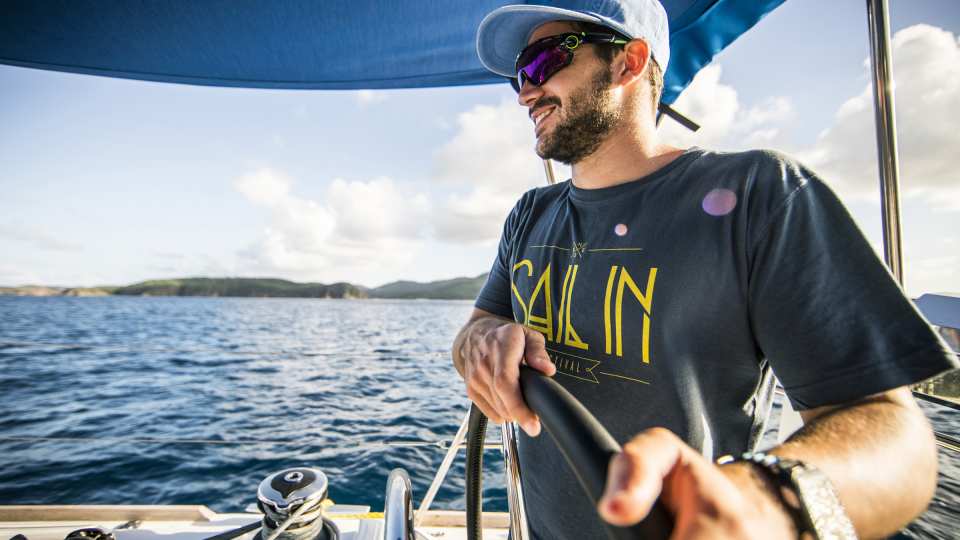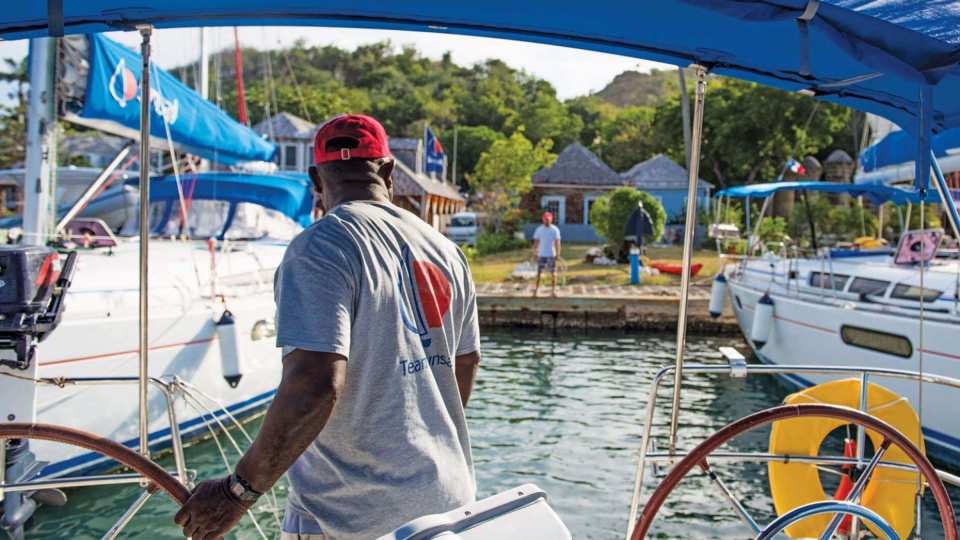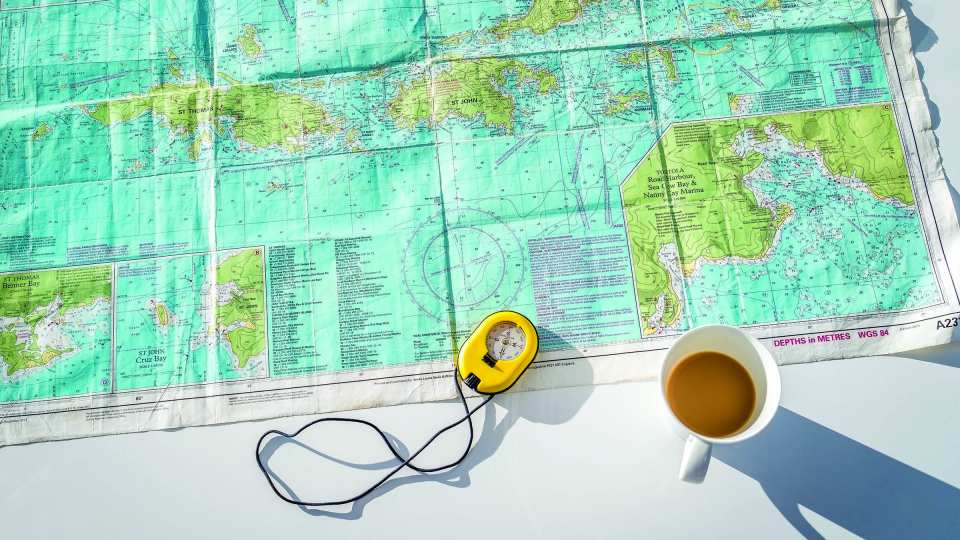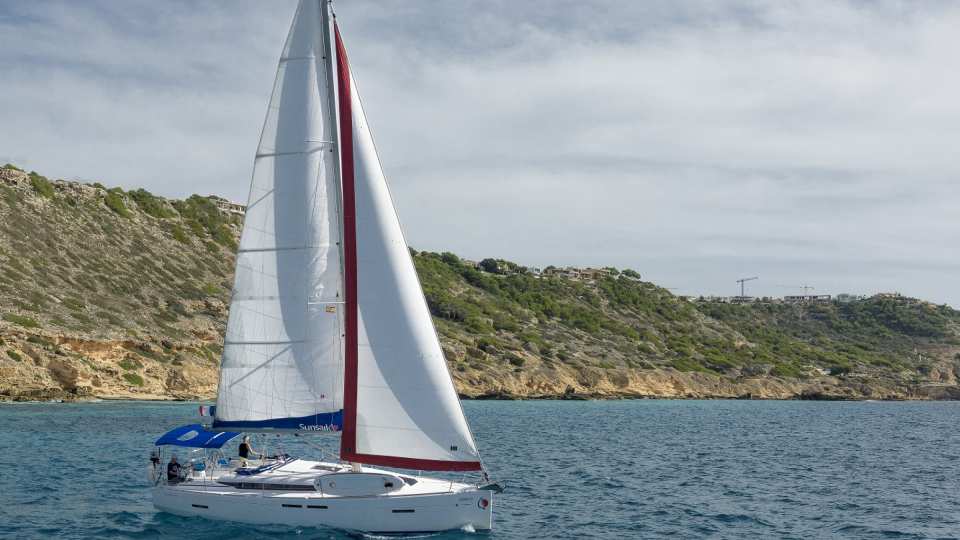
So, you’ve put in the nautical miles, earned your RYA Day Skipper, ICC, or beyond, and are keen to get out and explore. You may be a seasoned yachtsman who’s racked up more hours on watch than they’ve had hot dinners. However, even after studying the ins and outs of meteorology, pilotage, and passage making, it’s important to remember that becoming and remaining ‘the heart of the vessel’ takes decisiveness, great communication skills, and the confidence that comes with practice.
Chief Instructor of Sunsail Sailing School in Lefkas, Peter Wilkinson, explains, “The first time you take a boat out on your own as the skipper can be daunting, but the only way to build up your experience and confidence is to get out there and sail!” Inspired to brush up on or improve your sailing skills? With over 20 years’ experience on the water, why not take a look at some of Peter’s top sailing, manoeuvring, and navigation tips to help you and your crew stay safe and enjoy your time on the water.
1. What to think about when YOU are the skipper!
When you’re sat in the cockpit about to set sail on your voyage, it’s important that before you put out, you ask yourself these four key questions:
- Is the boat safe? – Not going to run aground, into another boat or any other hazard?
- Is the boat happy? – Reefed down for the wind you have? Is the sail trim good? Are you on course?
- Are the crew safe? – Is everyone wearing lifejackets? Are the safety lines firmly attached? Are the crew out of the way of the boom?
- Are the crew happy? – Do they know the sailing itinerary? Have they enough food and water for the trip? Are they warm/cool enough? Have you factored in enough time to get to the destination so that the crew can get showered, and fed?
You may find that these four questions occupy most of your time – especially ensuring that your crew are happy throughout the journey!

2. Helming the boat under strong wind gusts
It’s good to get into the habit of sailing with the main sheet on a winch and with an open jammer. This way, if you find yourself getting caught by sudden wind gusts, and the helm is having trouble controlling the boat, or you get broached, you can depower the main sail by releasing the main sheet quickly. By using the command “Dump the main!” you can depower completely or choose to “Ease the main”, if you want only some power taken out of the main sail to avoid rounding up. With the main sail depowered, you are then in a good position to reef down. If the wind conditions are marginal for reefing down, then station one of the crew members by the main sheet winch so they can dump or ease the main if and when required.
3. Reefing down under sail
There is temptation when hit with big gusts to put on the engine, turn the boat into the wind, and begin reefing. However, this usually results in a lot of noise and confusion. With the skipper at the helm shouting orders at the crew, the sheets, sails, and boom will be flogging all over the place, causing unnecessary stress and pressure for the skipper and crew. Instead, aim to reef down under the sail to gain control of the helm and keep the crew calm until the gusts ease off.
With the main sail depowered (see Tip No2) the boat will be upright and under control. Instruct the helm to sail the boat on a close reach using the genoa, leaving the main sail depowered. Reef the main sail in accordance with the wind conditions. Then put the boat on a broad reach so that the main sail shields the genoa (making it easier to furl), and reefs the genoa. When both sails are reefed down, trim for the required point of sail and continue on your passage. It may be good to practice this with new crew members so that everyone knows what the protocol is under strong gusts.
4. How to tack, without wearing out your crew
If you are short-tacking or having to tack frequently on an upwind passage, then save your crew, wearing themselves out and winching the genoa sheets, by using ‘hesitation tacking’. This is when the helm waits for the genoa to come across in the tack and then holds up the turn to allow the crew time to set and trim the foresail before going onto the required point of sail. With continued practice, the crew should be able to set the genoa with little to no winching. They will definitely thank you for it!
Be close-hauled when sailing upwind. To be close-hauled while sailing efficiently upwind, you need to stay within 2˚ of your best upwind wind angle. You should know when you are close-hauled because you will be able to feel the boat heel and accelerate. The helm’s job is to find this groove and keep her there!
5. Use prop walk to your advantage
You need to turn the boat 180˚ in a close quarters manoeuvre. You may be in a marina aisle looking for a berth or executing a turn in a narrow channel or anchorage. This is when you use your prop walk (or prop kick) to your advantage. For example, if you have a port prop walk, then always turn the boat to starboard if manoeuvring in a confined space. After this, you need to stop the boat, then turn the wheel fully to starboard. Using short bursts of engine power in forward gear, you can start the turn. As the boat turns half-way, you need to keep the wheel fully locked over on the starboard side and use bursts of power in reverse to continue the turn. Repeat this manoeuvre until the turn is complete. If you have a starboard prop walk, then simply turn the wheel to port.

6. Berthing stern-to in a cross wind? No problem!
It is usually the skipper’s job to berth the boat. A cross wind can make this a bit difficult, whether you are coming in stern-to using the anchor, picking up a lazy line, or going into a finger pontoon. Firstly, you should prepare your lines and fenders for a stern-to park. Next, inform the crew to get the windward stern line on first. When the line is on and with your wheel centred, you can hold the boat perpendicular to your spot by keeping the engine tick-over forward (or more if the wind requires it) while the crew sorts out the rest of the lines.
7. Berthing alongside short-handed? Again, no problem!
With only two of you on board, you don’t want to have someone leaping ashore and dashing around trying to get the boat tied up, particularly if you are being blown off your berth. Prepare the boat for berthing with the lines and fenders you need. Prepare a short line with a large bowline on the end and attach the line to the centre cleat on your boat. When the boat comes alongside, drop the bowline onto a pontoon cleat at the right spot, and the boat will come to a stop with the bows in (make sure there is a fender near the front of the bow). If you leave the engine in tick-over forward, she will stay put while you and the crew sort out the rest of the lines. If you have used the end of a longer line for your short line, then you can easily convert this to a bow or stern spring line once the bow and stern line are on!
8. Use a ‘position fixing’ waypoint to make the navigator’s job easier
A useful technique for quick, accurate position fixing on passage is to select an arbitrary waypoint in the centre of your sailing area that is easy to enter into your GPS. Select one at a charted intersection of latitude and longitude. Mark it on the chart. Tell the GPS to GOTO this waypoint. It will then give you the distance and bearing to that waypoint that can be used to fix position when you complete the ship’s log every hour. It is very quick and easy to plot using this method, as you’re less likely to make errors than when plotting lat/long. Good selection of your waypoint will also minimise the number of destinations or route waypoints you will need to enter and will help keep your position track marked on the chart, as it should be! If you have a long passage, then you can always use more than one waypoint for position-fixing purposes.
A good habit to get into, is to check your electronic position, using traditional alternatives such as contours, bearings or proximity to a charted object (and vice versa).

9. Clearing bearings
Use clearing bearings to avoid hazards when sailing out of or into a port or in pilotage situations. Draw a line on the chart that avoids the hazard and measure it. This becomes your clearing bearing, which you write down and add the comment “or less/or more” to avoid hazards. You can then use dual clearing bearings to avoid one or more hazards, if tacking.
Applying the knowledge you’ve gained in sailing school courses and hours on the water to become a successful skipper may seem like a daunting experience, but it doesn’t have to be that way. Getting to grips with navigation and the maintenance of your yacht is key, but most importantly, it is about instilling confidence in your crew to handle any issues quickly and efficiently as a team. By adopting Peter’s top tips next time you take the helm, you can rest assured that you are well on your way to becoming an expert skipper!

Peter Wilkinson
Peter Wilkinson is an RYA Yachtmaster Instructor and is currently the Chief Instructor at the Sunsail Sailing School at Lefkas in Greece. Born in Malta, he started sailing in dinghies at the age of 13, big boats in his 20s and has been an RYA Instructor for the past 7 years, teaching in the UK, Canary Islands, Greece, Turkey and Croatia. His favourite sailing area is the west coast of Italy and Sicily, although the Adriatic and Aegean seas come a close second!
Contributor
Ian Pedersen
Step Aboard Here
Start your experience with Sunsail on land and sign up to receive e-mails from us about yachts, offers and destinations.
By clicking 'Sign up' you confirm that you have read and understood our Privacy Policy and consent to our use of your information.



